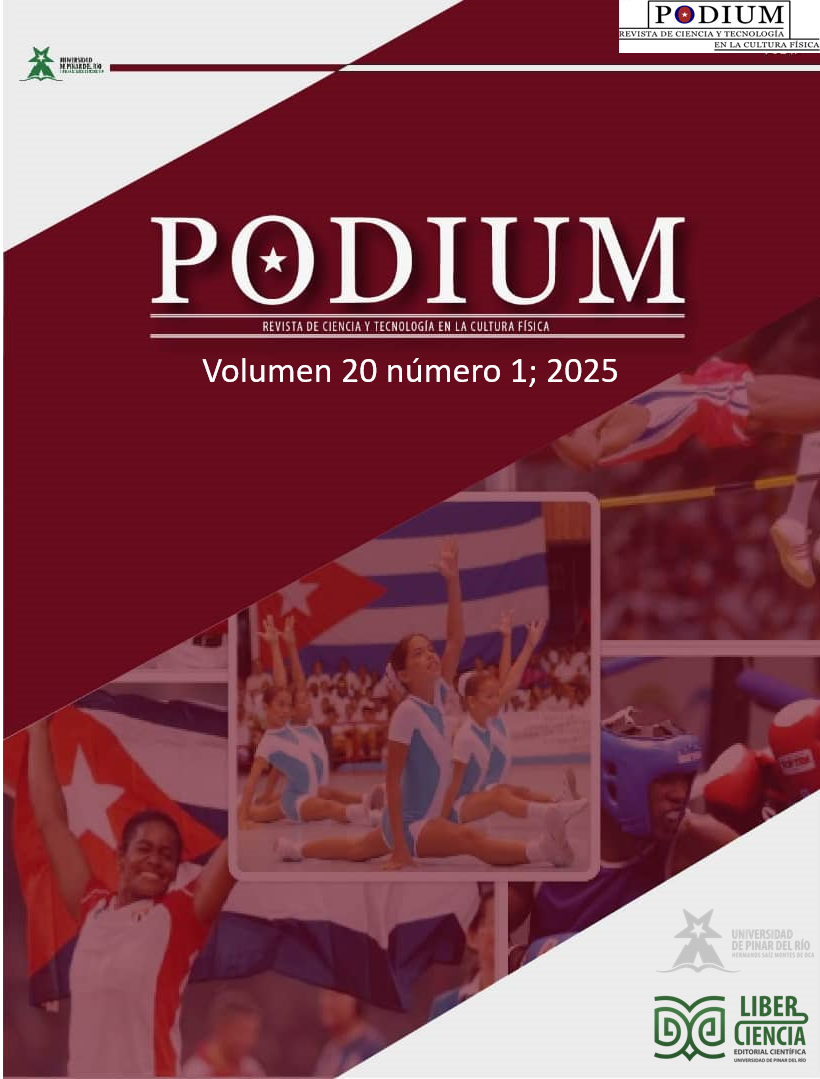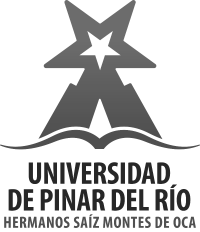Somatotipo e composição corporal em atletas da seleção Colombia de Cheerleading
##plugins.themes.bootstrap3.article.main##
Resumo
O objetivo desta pesquisa foi determinar o somatótipo e a composição corporal das atletas Cheerleading da seleção colombiana, diferenciadas entre as funções de base e voadora. Participaram do estudo 26 atletas (16 homens que desempenharam a função de base e 10 mulheres que desempenharam a função de flyer), que tiveram medidas antropométricas realizadas seguindo o protocolo da Sociedade Internacional para o Avanço da Cinantropometria (ISAK 2 para perfil restrito). A partir daí foram obtidos índices de massa corporal (IMC), percentuais de gordura, músculo e osso, componentes endomórficos, mesomórficos e ectomórficos que determinam o somatótipo. O tempo de experiência de cada atleta foi levado em consideração para determinar o tempo de prática ativa da modalidade expresso em meses. Foram calculadas medidas descritivas como média e desvio padrão. A partir dos resultados infere-se que um alto nível de habilidade em Cheerleading em nível competitivo nacional e internacional pode ser alcançado por atletas que possuam experiência adequada e um somatótipo mesomórfico nas bases masculinas, e um somatótipo ectomórfico balanceado nas voadoras femininas. Existem diferenças entre as duas funções, sendo as bases maiores que as dos voadores, porém, nota-se a importância do componente muscular em homens e mulheres para o bom desempenho das diferentes habilidades deste esporte. Até onde sabemos, isso fornece a primeira avaliação da composição corporal e do somatotipo em Cheerleaders competitivas em nível de seleção nacional.
Downloads
##plugins.themes.bootstrap3.article.details##

Este trabalho encontra-se publicado com a Creative Commons Atribuição-NãoComercial 4.0.
Referências
Asociación Médica Mundial (AMM). (2018). Declaración de Helsinki de la AMM Principios éticos para las investigaciones médicas en seres humanos WMA The World Medical Association. https://www.wma.net/es/policies-post/declaracion-de-helsinki-de-la-amm -principios-eticos-para-las-investigaciones-medicas-en-seres-humanos/
Bakhareva, N. S., Baibakov, S. E., Yulmukhametov, D. R., Gordeeva, E. K., & Bakhareva, A. A. (2018). Somatotypological Characteristic of the Representatives of Different Age Periods and Its Importance in Sports Orientation. Kuban Scientific Medical Bulletin, 25(6), 3237. https://doi.org/10.25207/1608-6228-2018-25-6-32-37
Carter, J. E. . (1982). The Physical Structure of Olympic Athletes Part I The Montreal Olympic Games Anthropometrical Project. British Journal of Sports Medicine, 16(4), 267.1-267. https://doi.org/10.1136/bjsm.16.4.267
Deng, C., Yu, Q., Luo, G., & Lu, S. (2022). Effects of 16 Weeks of Cheerleading on Physical Self-Esteem and Mental Health of Female College Students. Frontiers in Psychology, 13(June), 18. https://doi.org/10.3389/fpsyg.2022.925162
Di Cagno, A., Baldari, C., Battaglia, C., Monteiro, M. D., Pappalardo, A., Piazza, M., & Guidetti, L. (2009). Factors influencing performance of competitive and amateur rhythmic gymnastics-Gender differences. Journal of Science and Medicine in Sport, 12(3), 411416. https://doi.org/10.1016/j.jsams.2008.01.006
Faulkner, J. A. (1968). Physiology of swimming and diving. In Exercise Physiology. Baltimore Academic Press.
García-Chaves, D. C., Corredor-Serrano, L. F., & Díaz Millán, S. (2023). Relationship between explosive strength, body composition, somatotype and some physical performance parameters in rugby seven players. Retos, 47, 103109.
International Olympic Committee. (2016). International Olympic Committee, provisional recognition to International Cheer Union (ICU). Suplement IOC.
ISAK. (2011). International Standards fir Anthropometric Assessment.
Jakovljeviæ, V., Bošnjak, G., Pašiæ, G., & Tešanoviæ, G. (2022). Roll of Somatotype in Sport Selection. Acta Kinesiologica, 16(1), 8492. https://doi.org/10.51371/issn.1840-2976.2022.16.1.11
Jovanoviæ, S., Bijeliæ, S., Živèiæ, K., Milèiæ, L., & Možnik, M. (2024). Some Anthropometric Characteristics of Gymnasts and the Influence on Apparatus Performance. Kinesiologia Slovenica, 30(1), 141153. https://doi.org/10.52165/kinsi.30.1.141-153
Krivoruchko, N. V., Masliak, I. P., Bala, T. M., Skripka, I. N., & Honcharenko, V. I. (2018). The influence of cheerleading exercises on the demonstration of strength and endurance of 15-17-year-olds girls. Physical Education of Students, 22(3), 127. https://doi.org/10.15561/20755279.2018.0303
Lee, R. C., Wang, Z., Heo, M., Ross, R., Janssen, I., & Heymsfield, S. B. (2000). Total-body skeletal muscle mass: Development and cross-validation of anthropometric prediction models. The American Journal of Clinical Nutrition, 72(3), 796803. https://doi.org/10.1093/ajcn/72.3.796
Masanovic, B., Popovic, S., & Bjelica, D. (2019). Comparative study of anthropometric measurement and body composition between basketball players from different competitive levels: elite and sub-elite. Pedagogics, Psychology, Medical-Biological Problems of Physical Training and Sports, 23(4), 176181. https://doi.org/10.15561/18189172.2019.0403
Masiá, C. R., Pérez, S. S., & Anta, R. C. (2021). Anthropometric profile in Rhythmic Gymnasts of different performance levels: A comparative study. Revista Espanola de Nutricion Humana y Dietetica, 25, 127. https://doi.org/10.14306/renhyd.25.S1.1257
Miletiæ, M., Aksoviæ, N., Bjelica, B., Velièkoviæ, S., & Iliæ, H. S. (2022). Effects of the Acrobatic Program on the Body Composition and Flexibility of Adolescents. Facta Universitatis, Series: Teaching, Learning and Teacher Education, 6(1), 3341. https://doi.org/10.22190/futlte211225017m
Navarro, V. T. (2020). Composición Corporal Y Somatotipo DeJóvenes Deportistas De Alto Nivel DeAtletismo, Natación Y Triatlón. Revista Española De Educación Física Y Deportes.
Penna, G., Zecca, G., Altavilla, G., D'Isanto, T., & Russo, L. (2023). Can somatotype influence the static postural control? A new proposal of investigation. Journal of Human Sport and Exercise, 18(3), 586595. https://doi.org/10.14198/jhse.2023.183.07
Pons, V., Riera, J., Galilea, P. A., Drobnic, F., Banquells, M., & Ruiz, O. (2015). Características antropométricas, composición corporal y somatotipo por deportes. Datos de referencia del CAR de San Cugat, 1989-2013. Apunts. Medicina de l'Esport, 50(186), 6572. https://doi.org/10.1016/J.APUNTS.2015.01.002
Quintero, A. M., De La Rosa, A., Chagnaud, C. A., Quintero, J. M. G., & Moro, A. R. P. (2023). Morphology, lower limbs performance and baropodometric characteristics of elite Brazilian Jiu-jitsu athletes. Ido Movement for Culture, 23(2), 5869. https://doi.org/10.14589/ido.23.2.8
Quintero, A. M., Fuentes-Garcia, J. P., Poblete-Valderrama, F., de Andrade, G. A. P., & De la Rosa, A. (2024). Body composition, power muscle, and baropodometric assessment in elite Muay Thai athletes. Ido Movement for Culture - Journal of Martial Arts Anthropology, 24(3), 1222. https://doi.org/10.14589/ido.24.3.2
Reale, R., Burke, L. M., Cox, G. R., & Slater, G. (2020). Body composition of elite Olympic combat sport athletes. European Journal of Sport Science, 20(2), 147156. https://doi.org/10.1080/17461391.2019.1616826
Rocha, M. (1975). Peso ósseo do brasileiro de ambos os sexos de 17 a 25 años. Arq. Anat. Antropol., 1, 445451.
Routman, C. (2023). Training Specificity and Functional Performance in Collegiate Cheerleaders.
Ryan-Stewart, H., Faulkner, J., & Jobson, S. (2018). The influence of somatotype on anaerobic performance. PLoS ONE, 13(5), 111. https://doi.org/10.1371/journal.pone.0197761
Salas-Morillas, A., Gutiérrez-Sánchez, Á., & Vernetta-Santana, M. (2022). Composición Corporal y Rendimiento Deportivo en Gimnastas de Acrobática. International Journal of Morphology, 40(1), 220227. https://doi.org/10.4067/s0717-95022022000100220
Sánchez, P. U., & Elizondo, J. H. (2021). Energy expenditure and intensity of cheerleading training: A descriptive study. MHSalud, 18(2), 114. https://doi.org/10.15359/MHS.18-2.8
Sterkowicz-Przybycien, K., & Gualdi-Russo, E. (2019). Evaluation of somatotype in artistic gymnastics competitors: A meta-analytical approach. Journal of Sports Medicine and Physical Fitness, 59(3), 449455. https://doi.org/10.23736/S0022-4707.18.08332-9
Sterkowicz-Przybycieñ, K., Sterkowicz, S., Biskup, L., Zarów, R., Kryst, £., & Ozimek, M. (2019). Somatotype, body composition, and physical fitness in artistic gymnasts depending on age and preferred event. PLoS ONE, 14(2), 121. https://doi.org/10.1371/journal.pone.0211533
Stroescu, S. A. (2018). The importance of safety rules in cheerleading. European Proceedings of Social and Behavioural Sciences. http://dx.doi.org/10.15405/epsbs.2018.03.10
Suchomel, T. J., Nimphius, S., Bellon, C. R., & Stone, M. H. (2018). The Importance of Muscular Strength: Training Considerations. Sports Medicine, 48(4), 765785. https://doi.org/10.1007/s40279-018-0862-z
Taboada-Iglesias, Y., Gutiérrez-Sánchez, Á., Alonso-Fernández, D., & Vernetta-Santana, M. (2021). Somatotype analysis by age categories in spanish female acrobatic gymnasts. Science of Gymnastics Journal, 13(1), 7184. https://doi.org/10.52165/sgj.13.1.71-84
Thomas, D., Seegmiller, J., Cook, T., & Young, B. (2004). Physiologic profile of the fitness status of collegiate cheerleaders. Journal of Strength and Conditioning Research, 18(2), 252254.
Timofeeva, O. V., Lubyshev, E. A., Ibragimova, N. A., & Vyprikov, D. V. (2021). Anthropometric Analysis and Body Sculpt Improvement in Application To Female Students From Cheerleading Picked Teams. Teoriya i Praktika Fizicheskoy Kultury, 12, 8586.
Vernetta Santana, M., Salas Morillas, A., Peláez-Barrios, E. M., & López-Bedoya, J. (2021). Calidad de movimiento en adolescentes practicantes y no practicantes de Gimnasia Acrobática mediante la batería Funtional Movement Screen (Quality of movement in Acrobatic Gymnastics teenagers and non-practitioners using the Funtional Movement Screen bat. Retos, 41(2017), 879886. https://doi.org/10.47197/retos.v41i0.86349
Weldon, A., Duncan, M. J., Turner, A., Lockie, R. G., & Loturco, I. (2022). Practices of strength and conditioning coaches in professional sports: A systematic review. Biology of Sport, 39(3), 715726. https://doi.org/10.5114/BIOLSPORT.2022.107480


